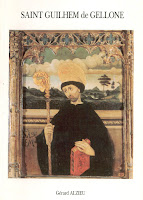His Story:
St. William was chosen by the Great Emperor to lead his army in a campaign against the invaders from Moors in France and Spain , He fought with distinction. William defeated the invaders at Orange , as a result King Charles named him Duke of Aquitaine to repay him for his service.
Throughout his military career, he displayed exemplary chivalry and was honored as the ideal knight. However, he gave up the sword and became dedicated to the promotion of the faith. In 804, William founded a monastery at Gellone, and assigned the direction of this monastery to the famed St. Benedict of Aniane, father of Western monks. In 806, with King Charles permission, William entered the monastery as a monk, practicing the angelic habit until his holy death in May 28, 812. He was canonized in 1066 by Pope Alexander II.
Facts:
Born: 755 AD,France
Died: 28 May, c. 812 AD, Saint-Guilhem-le-DésertFrance
Born: 755 AD,
Died: 28 May, c. 812 AD, Saint-Guilhem-le-Désert
Founder: Benedictine Monastery, he himself became a Monk until his death.
Beatified in 1066
Feast Day: May 28, the day of his death.
Children: Bernard of Septimania, Bera, Count of Barcelona, Gaucelm, Teodoric III d'Autun
Parents: Aldana, daughter of Charles Martel, Thierry IV
Monk of St. Benedictine Order
References:
Additional Information:
- Catholic Encyclopedia
- books
- Book of Saints, by the Monks of Ramsgate
- Our Sunday Visitor’s Encyclopedia of Saints
- other sites in english
- sites en français
- siti in italiano











No comments:
Post a Comment